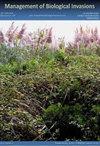Risk screening and management of alien terrestrial planarians in The Netherlands
IF 1.2
4区 环境科学与生态学
Q3 BIODIVERSITY CONSERVATION
引用次数: 4
Abstract
Worldwide over 910 terrestrial planarian species have been described. They mainly occur in tropical and subtropical regions. In Europe, 22 alien terrestrial planarian species have been recorded over the last decades. In The Netherlands, 9 alien species have been found so far, mostly in greenhouses. Three of these species have established populations in gardens (i.e., Marionfyfea adventor , Caenoplana variegata and Parakontikia ventrolineata ). Alien terrestrial planarians that consume earthworms and are established outdoors can have a negative impact on biodiversity and soil quality by reducing earthworm populations. Their impact on earthworm populations can be high, but is difficult to assess due to limited knowledge of the feeding patterns and ferocity of most terrestrial planarian species. Risk assessments for The Netherlands carried out with the Harmonia + scheme shows that only the New Zeeland land planarian Arthurdendyus triangulatus scores high for potentially risks due to its ability to significantly reduce earthworm densities. This species has not yet been found in The Netherlands, but already occurs in the United Kingdom, Ireland, and Iceland. Obama nungara obtained a medium risk score and all other species a low risk score. Due to the limited information about terrestrial planarians and their potential impact, the certainty of most risk scores is low to moderate. Therefore, it is recommended to update their risk assessments periodically based on new information about their invasion biology. Phytosanitary measures can limit the unintentional import of alien planarian species.荷兰外来陆生涡虫的风险筛查和管理
全世界已发现的陆生涡虫物种超过910种。它们主要分布在热带和亚热带地区。在欧洲,在过去的几十年里已经记录了22种外来的陆生涡虫物种。在荷兰,迄今为止已经发现了9种外来物种,大部分是在温室里发现的。其中3种已在园林中建立种群(即:marionfytea adventor、caenplana variegata和Parakontikia ventrolineata)。以蚯蚓为食并在户外生活的外来陆生涡虫会减少蚯蚓的数量,从而对生物多样性和土壤质量产生负面影响。它们对蚯蚓种群的影响可能很大,但由于对大多数陆生涡虫物种的摄食模式和凶猛程度的了解有限,因此难以评估。根据Harmonia +计划对荷兰进行的风险评估显示,只有新西兰的陆地涡虫Arthurdendyus triangulatus在潜在风险方面得分较高,因为它能够显著降低蚯蚓密度。这一物种尚未在荷兰被发现,但已经在英国、爱尔兰和冰岛出现。奥巴马南加拉获得了中等风险评分,而所有其他物种都获得了低风险评分。由于有关陆生涡虫及其潜在影响的信息有限,大多数风险评分的确定性为低至中等。因此,建议根据其入侵生物学的新信息,定期更新其风险评估。植物检疫措施可以限制外来涡虫物种的非故意输入。
本文章由计算机程序翻译,如有差异,请以英文原文为准。
求助全文
约1分钟内获得全文
求助全文
来源期刊

Management of Biological Invasions
Agricultural and Biological Sciences-Ecology, Evolution, Behavior and Systematics
CiteScore
3.40
自引率
6.70%
发文量
21
审稿时长
16 weeks
期刊介绍:
Management of Biological Invasions, established in 2010 by Dr. Elias Dana, is an open access, peer-reviewed international journal focusing on applied research in biological invasions in aquatic and terrestrial ecosystems from around the world. This journal is devoted to bridging the gap between scientific research and the use of science in decision-making, regulation and management in the area of invasive species introduction and biodiversity conservation.
Managing biological invasions is a crisis science, with Management of Biological Invasions aiming to provide insights to the issues, to document new forms of detection, measurements and analysis, and to document tangible solutions to this problem.
In addition to original research on applied issues, Management of Biological Invasions publishes technical reports on new management technologies of invasive species and also the proceedings of relevant international meetings. As a platform to encourage informed discussion on matters of national and international importance, we publish viewpoint papers that highlight emerging issues, showcase initiatives, and present opinions of leading researchers.
 求助内容:
求助内容: 应助结果提醒方式:
应助结果提醒方式:


